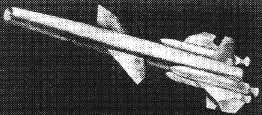APL SSM-N-2 Triton
In September 1946, the U.S. Navy formally approved the Triton strategic surface-to-surface missile program. In September 1947, the designation SSM-2 was allocated to the project, changed to SSM-N-2 in early 1948. The Triton was a very ambitious project, and the first years were spent with formulating performance objectives and possible design baselines to achieve these objectives.
By 1950, the XSSM-N-2 had been designed as a 16300 kg (36000 lb) ramjet-powered cruise missile with solid-propellant rocket boosters, achieving a range of 3700 km (2000 nm) at a speed of Mach 1.6-2.5. For midcourse guidance, an inertial system supplemented by a day-time star tracker or a magnetic guidance system were studied, while terminal homing options included infrared and radar map-matching systems. The accuracy was specified at 550 m (600 yd) CEP. The missile was to be launchable from surface ships and submarines, and be compatible with gear used for the SSM-N-8/RGM-6 Regulus. Warhead weight was to be around 1800 kg (4000 lb).
 |
| Drawing: via AIAA |
| XSSM-N-2 (1951 design) |
The 1950 requirements apparently proved to be too ambitious, and by 1955, the gross weight, range and warhead weight figures had been reduced to 12400 kg (27300 lb), 2200 km (1200 nm) and 680 kg (1500 lb), respectively. This design was eventually approved for full-scale development, with an operational missile expected for around 1965. However, the Triton project was cancelled in 1957 (after the design parameters had again slightly changed), and no XSSM-N-2 vehicles were ever flown (in fact, it's not unlikely that none were even completed). At that time, the SSM-N-2 would have been only a marginal improvement over the SSM-N-9/RGM-15 Regulus II, and the forthcoming UGM-27 Polaris SLCM made the Triton an obsolete concept anyway.
Specifications
Note: Data given by several sources show slight variations. Figures given below may therefore be inaccurate!
Data for XSSM-N-2 (approximate figures for final design, 1957):
| Length | 14.3 m (47 ft) |
| Diameter | 1.45 m (57 in) |
| Weight | 13600 kg (30000 lb) |
| Speed | Mach 3.5 |
| Ceiling | 24100 m (80000 ft) |
| Range | 2800 km (1500 nm) |
| Propulsion | Sustainer: ramjet; booster: solid-fueled rocket |
| Warhead | W-27 thermonuclear (2 MT) |
Main Sources
[1] Norman Friedman: "US Naval Weapons", Conway Maritime Press, 1983
[2] Frederick I. Ordway III, Ronald C. Wakeford: "International Missile and Spacecraft Guide", McGraw-Hill, 1960
[3] Bill Gunston: "The Illustrated Encyclopedia of Rockets and Missiles", Salamander Books Ltd, 1979
[4] Kenneth P.Werrell: "The Evolution of the Cruise Missile", Air University Press, 1985
Back to Directory of U.S. Military Rockets and Missiles, Appendix 1
Last Updated: 20 January 2003